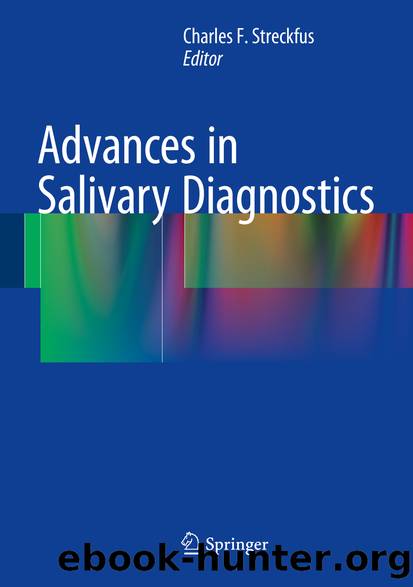Advances in Salivary Diagnostics by Charles F. Streckfus

Author:Charles F. Streckfus
Language: eng
Format: epub
Publisher: Springer Berlin Heidelberg, Berlin, Heidelberg
Herpes Viruses
Herpes viruses are the most common viral type found in human saliva [321–323]. There are eight known herpes viruses that infect humans: herpes simplex types 1 and 2, cytomegalovirus, Epstein-Barr virus, varicella zoster virus, herpes virus 6, herpes virus 7, and herpes virus 8 (Kaposi’s sarcoma) [324]. Herpes viral infections can lead to diseases of the periodontium and oral mucosa or may present asymptomatically but still with active viral shedding into saliva [322, 324]. Herpes viruses exist in either the lytic (active) or latent (dormant) phase [324] and persist as a permanent infection of the host. The change from dormant to active replication in healthy adults can happen spontaneously or more likely is caused by environmental changes (e.g., physical or emotional stress) [325–332]. Those suffering from systemic diseases (e.g., HIV, cancer) or immunosuppression (e.g., elderly) often display a reactivation of herpes viruses that may exacerbate or create new symptoms.
Thorough work looking at astronauts has shown that in space otherwise healthy adults shift into a state of immuno-dampening [326, 333]. Viruses that are normally kept in check by the body’s immune system start to flourish and result in oral shedding. Epstein-Barr virus and varicella zoster are found in enormous quantities while the astronauts are in space for several weeks after returning to earth [326, 328, 329]. A similar herpes zoster viral shedding is also seen in some pregnant women [334]. Cold sores caused by herpes simplex 1 virus tend to come back during times of stress [334, 335]. This allows the normally latent virus to take hold and cause an active disease again. Aging adults often fail to control reactivation of Epstein-Barr virus, cytomegalovirus, and/or varicella zoster viruses [336]. The latter virus results in the development of painful shingles disease that can last for several weeks or months. All of the patients mentioned above exhibited some type of change or challenge to their immune system leading to increased viral load in their saliva. Yet, healthy adults can also continually shed various herpes viruses. These healthy adults are often asymptomatic and may easily spread the viruses [333, 335, 337].
Interesting research has shown that herpes virus infection is associated with periodontitis. A dual infection of both oral pathogenic bacteria and a herpes virus leads to immune signaling impairment, enhanced proinflammatory cytokine release, and more severe periodontitis [223, 313, 338, 339]. A distinct correlation has been found with Epstein-Barr and cytomegalovirus between both gingivitis and periodontitis. The prevalence of Epstein-Barr genome copies in dental patients was evaluated in separate studies and showed an average of 8 % in healthy individuals and 20 % in those suffering from gingivitis [149, 150, 323, 340–343] along with 46 % for chronic periodontitis and 58 % for aggressive periodontitis [149, 150, 340, 343–347]. Studies focused on cytomegalovirus showed similar results with a positive correlation between gingivitis/periodontitis and viral infection (average 8 % healthy, 33 % gingivitis, 52 % chronic periodontitis, and 42 % aggressive periodontitis) [149, 150, 221, 323, 341, 343, 344, 346, 348]. Periodontal lesions have been implicated as the main salivary source of the cytomegalovirus [341].
Download
This site does not store any files on its server. We only index and link to content provided by other sites. Please contact the content providers to delete copyright contents if any and email us, we'll remove relevant links or contents immediately.
| Administration & Medicine Economics | Allied Health Professions |
| Basic Sciences | Dentistry |
| History | Medical Informatics |
| Medicine | Nursing |
| Pharmacology | Psychology |
| Research | Veterinary Medicine |
Essentials of Biostatistics in Public Health by Sullivan & Sullivan(1378)
Critical Thinking: Understanding and Evaluating Dental Research by Donald Maxwell Brunette(1328)
One of the Guys by A.R. Perry(1210)
The Dental Diet by Steven Lin(1196)
Basic Biostatistics by B. Burt Gerstman(1181)
Tooth Whitening Techniques by Linda Greenwall(1150)
0263927350 by A. L. Bird(1104)
ACT Prep 2019 by Kaplan Test Prep(1100)
Cure Tooth Decay: Heal And Prevent Cavities With Nutrition - Limit And Avoid Dental Surgery and Fluoride [Second Edition] 5 Stars by Nagel Ramiel(1078)
46 Where There Is No Dentist by Where There Is No Dentist(1067)
Dental Practice: Get in the Game by Michael Okuji(1048)
Essential Dental Therapeutics by David Wray(1037)
Small Animal Dentistry by Heidi B. Lobprise(1025)
Bone Biology, Harvesting, Grafting For Dental Implants by Arun K. Garg(1009)
Dental Caries by Zhou Xuedong(998)
A Textbook of Dental Homoeopathy by Dr Colin B. Lessell(998)
Dentistry with a Vision: Building a Rewarding Practice and a Balanced Life by Gerald I. Kendall Gary S. Wadhwa(995)
Fundamentals of Operative Dentistry by James B. Summitt(991)
Uncomplicate Business: All It Takes Is People, Time, and Money by Howard Farran(941)
